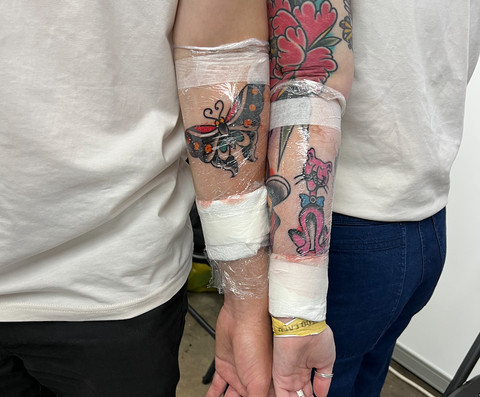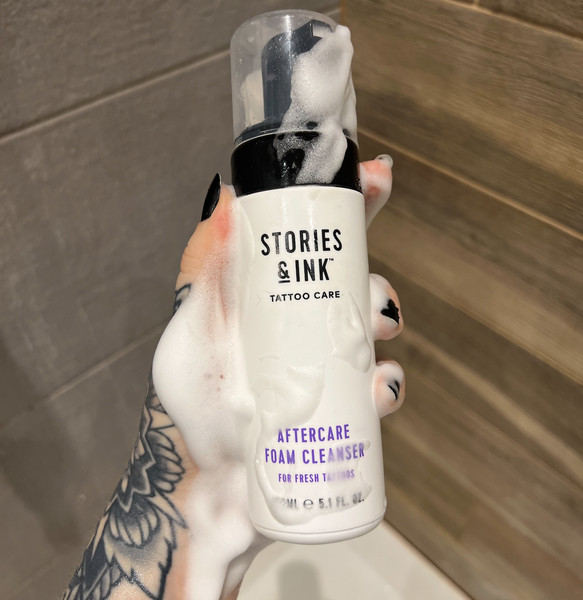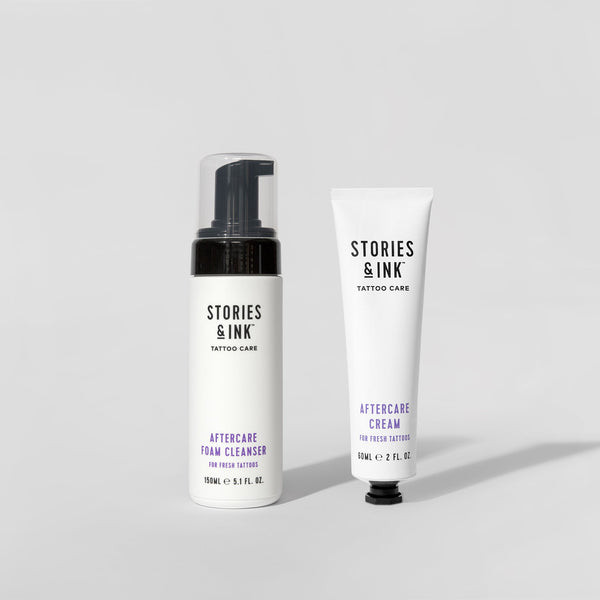So, How Long Does It Take A New Tattoo To Heal? Generally, a new tattoo takes about 2 to 4 weeks to heal on the surface, but the complete healing process can take up to 6 months. At tattooat.com, we want to ensure your body art looks vibrant for years to come, understanding the tattoo healing timeline, proper aftercare techniques, and potential complications is critical for preserving the ink artwork. Let’s dive into each stage of the healing process to help you achieve a beautifully healed tattoo.
1. Understanding How Tattoos Interact with Your Skin
Before diving into the healing timeline, it’s helpful to know how a tattoo is applied and how your skin responds.
1.1 The Tattooing Process
Tattooing involves using a needle to inject ink into the dermis, the layer of skin beneath the epidermis. Liv Dodds, a tattoo artist from Northumberland, UK, explains that the ink is recognized by your body as a wound, triggering an immune response. Macrophages, a type of white blood cell, attempt to engulf the ink particles. These macrophages remain in the dermis, encapsulating the ink and making the tattoo visible.
1.2 Your Body’s Reaction
The tattooing process creates thousands of tiny punctures in your skin. This trauma causes inflammation, redness, and sometimes minor bleeding. Your body immediately starts working to repair the damage, initiating the healing cascade. The initial response is crucial, and proper aftercare during this period significantly impacts the final result.
 Tattooing Process
Tattooing Process
Illustration of the tattooing process, showing ink being deposited into the dermis layer of the skin to create permanent artwork.
2. The Initial 24 Hours: Critical First Steps
The first 24 hours after getting a tattoo are arguably the most important for ensuring proper healing.
2.1 Immediate Aftercare
Your tattoo artist will clean the newly inked area and apply a bandage or protective covering like a second skin. This covering protects the tattoo from bacteria and physical irritation. Follow your artist’s specific instructions on how long to leave the initial bandage on, as recommendations can vary. Some artists prefer traditional plastic wrap, while others opt for breathable, adhesive barriers like Saniderm or Tegaderm.
2.2 Keeping it Clean
“The most important part of the first 24 hours is keeping your tattoo clean and fresh,” says Liv Dodds. This means avoiding touching the tattoo and keeping it wrapped to minimize exposure to bacteria. Regular washing with a mild, fragrance-free cleanser helps keep the area cool and removes any blood or plasma that may seep out. Consider using Stories & Ink Aftercare Foam Cleanser, specially designed to soothe and repair damaged skin.
 Stories & Ink Aftercare Foam Cleanser
Stories & Ink Aftercare Foam Cleanser
Stories & Ink Aftercare Foam Cleanser designed to soothe, calm, and repair damaged skin immediately after tattooing, promoting a healthy healing process.
2.3 What to Expect
Expect some redness, swelling, and mild discomfort during the first 24 hours. These are normal reactions to the tattooing process. The tattooed area may feel warm to the touch. The goal is to minimize these symptoms through proper hygiene and gentle care.
3. The Tattoo Healing Timeline: A Week-by-Week Breakdown
Understanding the stages of tattoo healing can help you provide the best possible care and avoid complications.
3.1 Week 1: Inflammation and Initial Healing
- What’s happening: During the first week, your body is actively working to close the “wound.” Redness, swelling, and a burning sensation are common. You may also notice some oozing of clear or slightly blood-tinged fluid.
- How to care for your tattoo: Gently wash the tattoo two to three times a day with a mild, fragrance-free soap. Pat it dry with a clean paper towel and apply a thin layer of tattoo-specific aftercare ointment or balm. Avoid re-bandaging the tattoo, as this can trap moisture and bacteria.
- Things to avoid: Avoid direct sunlight, soaking the tattoo in water (baths, swimming), and wearing tight clothing that could rub against the area.
3.2 Week 2: Itching and Peeling
- What’s happening: As the tattoo heals, the outer layer of skin will begin to flake and peel, similar to a sunburn. Itching is a common symptom during this stage.
- How to care for your tattoo: Continue washing the tattoo gently and applying aftercare product. Resist the urge to scratch or pick at the peeling skin. Doing so can remove ink and lead to scarring.
- Things to avoid: Avoid using harsh soaps or exfoliants. Keep the area moisturized to reduce itching and promote natural peeling.
3.3 Weeks 3 and 4: Surface Healing
- What’s happening: By weeks three and four, the peeling should subside, and the tattoo will appear less vibrant. This is because a layer of dry skin can still be present.
- How to care for your tattoo: Continue moisturizing the area regularly. The dullness will gradually disappear as the skin fully regenerates.
- Things to avoid: Avoid prolonged sun exposure and continue to protect the tattoo with loose clothing or sunscreen once it’s fully healed.
3.4 Months 1 to 6: Complete Healing
- What’s happening: While the surface of the tattoo may look healed within a month, the skin beneath the surface is still repairing itself. This process can take up to six months.
- How to care for your tattoo: Maintain a regular moisturizing routine. Protect the tattoo from the sun with sunscreen to prevent fading.
- Things to avoid: Avoid using harsh chemicals or abrasive products on the tattooed area.
4. Factors Affecting Tattoo Healing Time
Several factors can influence how quickly a tattoo heals.
4.1 Tattoo Size and Placement
Larger tattoos and those covering extensive areas will generally take longer to heal than smaller, simpler designs. Tattoos in areas with a lot of movement, such as joints or areas where clothing rubs, may also experience slower healing.
4.2 Individual Health and Lifestyle
Your overall health, immune system, and lifestyle habits play a significant role in tattoo healing. People with strong immune systems and healthy lifestyles tend to heal faster. Conditions like diabetes or autoimmune disorders can slow down the healing process.
4.3 Aftercare Practices
Proper aftercare is paramount. Consistent cleaning, moisturizing, and protection from irritation and sun exposure will promote faster and more effective healing. Neglecting aftercare can lead to infections, scarring, and delayed healing.
4.4 Tattoo Ink and Technique
The type of ink used and the tattoo artist’s technique can also affect healing time. High-quality inks and experienced artists who use proper depth and technique can minimize trauma to the skin, leading to quicker healing. According to research from Portland State University’s Art Department, in July 2025, the use of organic tattoo inks provides faster healing times compared to traditional inks.
5. Potential Complications and How to Identify Them
While most tattoos heal without issue, it’s important to be aware of potential complications.
5.1 Infection
An infection can occur if bacteria enter the tattooed area. Signs of infection include:
- Persistent redness and swelling
- Increased pain
- Oozing of pus or colored discharge
- Fever or chills
- Skin that feels hot to the touch
If you suspect an infection, seek medical attention immediately.
5.2 Allergic Reactions
Some people may have allergic reactions to tattoo inks, particularly red and yellow pigments. Symptoms of an allergic reaction include:
- Severe itching
- Hives or rash
- Swelling
- Blisters
If you experience these symptoms, consult a doctor or dermatologist.
5.3 Scarring
Scarring can occur if the tattoo is not properly cared for or if the skin is damaged during the healing process. Picking at scabs or scratching the tattoo can increase the risk of scarring.
5.4 Keloids
Keloids are raised, thickened scars that can form around the tattoo. People with a history of keloid formation are more prone to this complication.
6. Tips for a Smooth Tattoo Healing Process
Here are some additional tips to promote optimal tattoo healing:
6.1 Choose a Reputable Artist
Select a tattoo artist with a strong reputation for hygiene and skill. Research studios and read reviews to ensure they follow proper sterilization and safety procedures.
6.2 Follow Aftercare Instructions
Adhere to your tattoo artist’s aftercare instructions diligently. If you have any questions or concerns, don’t hesitate to contact them.
6.3 Keep Hydrated
Drinking plenty of water helps keep your skin hydrated, which is essential for healing.
6.4 Eat a Healthy Diet
A nutritious diet rich in vitamins and minerals supports your body’s healing processes.
6.5 Avoid Alcohol and Smoking
Alcohol and smoking can impair the immune system and slow down healing.
6.6 Protect from the Sun
Sun exposure can cause tattoos to fade and can damage healing skin. Always protect your tattoo with loose clothing or sunscreen (once fully healed).
7. Dermatologist Insights on Tattoo Healing
Dr. Nicolas Kluger, a professor of Dermatology at Helsinki University Hospital, emphasizes that most tattoos should heal within two to four weeks. He notes that light tattoos heal faster than those with large areas of color. According to Dr. Kluger, tattoos located in areas of constant rubbing, like the ankle, may take longer to heal if not properly rested.
7.1 Medications and Healing
Certain medications, such as isotretinoin (for acne) and high doses of corticosteroids, can delay healing. If you are taking any medications, discuss this with your tattoo artist and your doctor.
7.2 Diabetes and Tattoos
Dr. Kluger advises that diabetic patients can safely get tattoos if their diabetes is well-controlled during the process.
8. Must-Do and Never-Do List for Tattoo Aftercare
| Do | Don’t |
|---|---|
| Wear loose clothing to your appointment | Submerge your tattoo in water (baths, pools, sea) |
| Keep it clean and moisturized | Let pets or animals rub against or lick it |
| Use natural/tattoo-friendly products | Heavily exercise for at least 48 hours |
| Let it breathe | Pick at it |
| Consult your tattoo artist with any questions | Expose your tattoo to direct sunlight |
9. Tattoo Healing: Addressing Frequently Asked Questions
Here are some common questions about tattoo healing.
9.1 How Long Does a Tattoo Take to Heal?
As mentioned earlier, a tattoo typically takes two to four weeks to heal on the surface, but complete healing can take up to six months.
9.2 What Does a Healing Tattoo Look Like?
A healing tattoo goes through several stages, including redness, swelling, oozing, peeling, and a dull appearance before the vibrant colors return.
9.3 What to Put on a Healing Tattoo?
Use a tattoo-specific aftercare ointment or balm. Stories & Ink Aftercare Cream is designed to soothe, calm, and repair damaged skin.
9.4 Can You Put Sunscreen on a Healing Tattoo?
No, avoid applying sunscreen to a healing tattoo. Sunscreen contains ingredients that can irritate the skin. Cover the tattoo with loose clothing instead. Once fully healed, sunscreen is essential to prevent fading.
10. The Ultimate Aftercare Duo: Stories & Ink
For optimal tattoo healing, consider using the Stories & Ink Aftercare Duo. This includes the gentle Aftercare Foam Cleanser and the hydrating Aftercare Cream, both formulated with natural, dermatologically-tested ingredients.
 Stories & Ink Aftercare Duo
Stories & Ink Aftercare Duo
Stories & Ink Aftercare Duo featuring gentle Aftercare Foam Cleanser and hydrating Aftercare Cream, ensuring optimal cleansing and healing for fresh tattoos.
10.1 Benefits of the Aftercare Duo
- Keeps fresh tattoos clean and free from bacteria
- Nourishes, hydrates, and reduces inflammation
- Helps your skin heal faster
- 100% natural, dermatologically-tested, fragrance-free, hypoallergenic, and vegan-friendly
11. Tattoo Styles and Their Impact on Healing
Different tattoo styles can influence the healing process due to variations in technique and ink density.
11.1 Minimalist Tattoos
Minimalist tattoos, characterized by fine lines and simple designs, tend to heal relatively quickly. The minimal ink coverage reduces trauma to the skin, facilitating faster recovery.
11.2 Traditional Tattoos
Traditional tattoos, often featuring bold lines and solid color, may require a bit more healing time due to the greater ink saturation. Proper moisturizing and cleaning are crucial for preventing scabbing.
11.3 Realism Tattoos
Realism tattoos, known for intricate details and shading, demand meticulous aftercare. These tattoos often involve multiple layers of ink, potentially extending the healing period.
11.4 Watercolor Tattoos
Watercolor tattoos, distinguished by soft, diffused colors, require careful attention during healing. The delicate nature of the ink application necessitates gentle cleaning and moisturizing to preserve the vibrancy of the design.
12. Seasonal Considerations for Tattoo Healing
The time of year can also affect how your tattoo heals.
12.1 Summer Tattoos
Summer poses challenges like increased sun exposure, sweating, and swimming. It’s crucial to protect your tattoo from the sun and avoid prolonged water submersion.
12.2 Winter Tattoos
Winter brings dry air and potential irritation from clothing. Moisturizing becomes even more important to prevent cracking and itching.
13. Tattoo Aftercare Products: A Closer Look
Choosing the right aftercare products can make a significant difference in your tattoo’s healing process.
13.1 Cleansers
Opt for mild, fragrance-free cleansers specifically designed for sensitive skin. Avoid harsh soaps that can strip the skin of its natural oils.
13.2 Moisturizers
Look for moisturizers that are hypoallergenic, non-comedogenic, and free of fragrances and dyes. Ingredients like shea butter, coconut oil, and vitamin E can promote healing and hydration.
13.3 Sunscreens
Once your tattoo is fully healed, use a broad-spectrum sunscreen with an SPF of 30 or higher to protect it from fading.
14. Debunking Common Tattoo Healing Myths
There are many misconceptions about tattoo healing. Let’s set the record straight.
14.1 Myth: You Should Re-Bandage Your Tattoo
Reality: Re-bandaging can trap moisture and bacteria, increasing the risk of infection.
14.2 Myth: Scabs Are Always Bad
Reality: Some scabbing is normal, but thick, excessive scabbing can indicate improper healing.
14.3 Myth: You Can’t Exercise After Getting a Tattoo
Reality: Light exercise is fine, but avoid intense workouts that cause excessive sweating and friction.
14.4 Myth: Tattoos Don’t Fade
Reality: All tattoos fade over time, but proper aftercare and sun protection can minimize fading.
15. Tattoo Healing and Mental Well-being
Getting a tattoo can be an exciting and empowering experience. Taking care of your new ink is not just about physical healing but also about self-care. Embrace the process, follow the guidelines, and enjoy your beautiful new body art. According to Inked Magazine, the act of getting a tattoo and caring for it can significantly boost self-esteem and body positivity.
16. Finding Inspiration and Artists at tattooat.com
Ready to explore the world of tattoos? Visit tattooat.com for a vast library of tattoo designs, a curated list of talented artists and studios, and detailed guides on tattoo aftercare and styles.
16.1 Discover Unique Designs
Find the perfect tattoo design that resonates with your personality and style.
16.2 Connect with Skilled Artists
Locate reputable tattoo artists in your area known for their expertise and artistry.
16.3 Access Expert Advice
Learn everything you need to know about tattoos, from preparation to long-term care.
Don’t wait to start your tattoo journey. Explore tattooat.com today and bring your artistic vision to life. Our vast resources and expert guidance will empower you to make informed decisions and achieve stunning results. Whether you’re seeking inspiration, connecting with artists, or mastering aftercare, tattooat.com is your ultimate destination.
Visit tattooat.com now to discover the art of tattooing and embark on a transformative experience. Let us help you turn your body into a canvas of self-expression and creativity.
